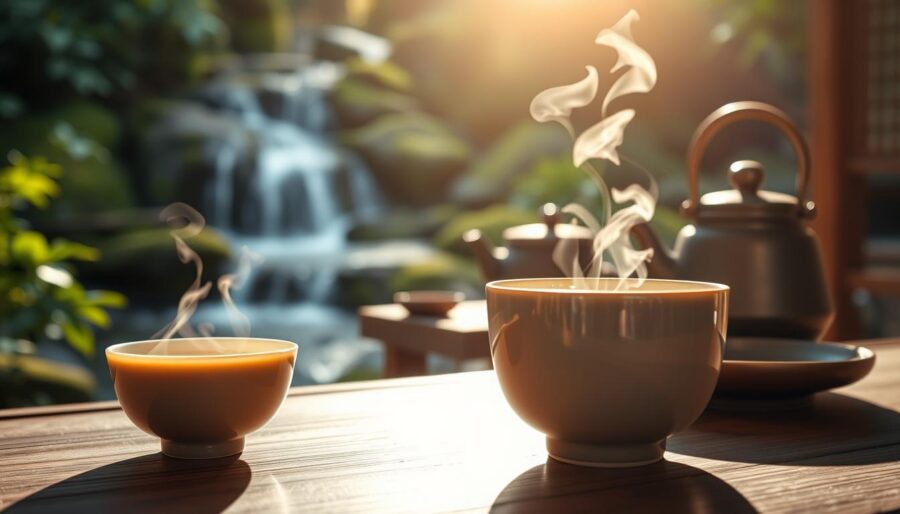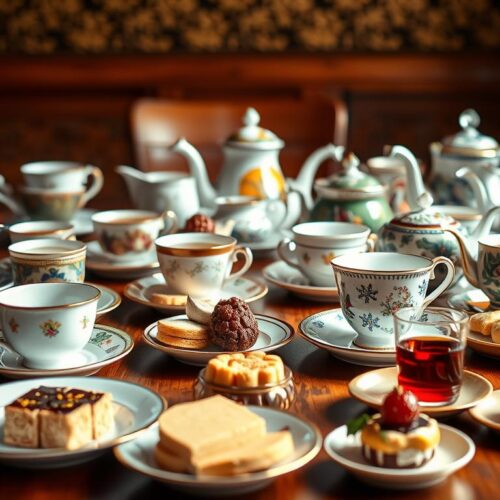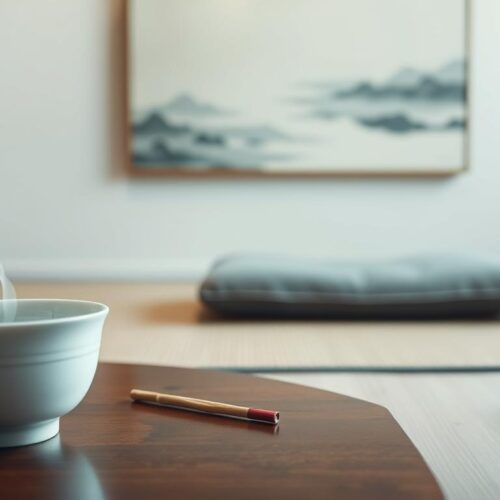Mindful tea drinking is not just about drinking tea. It’s a calm path to connect deeper with yourself and the world. When you follow Zen tea principles, making tea becomes a meditative act. This guide shows you how to be calm and fully present at every stage. From choosing your tea to enjoying each mouthful, it improves both your tea moments and mindfulness practice.
What is Mindful Tea Practice?
Mindful tea practice brings mindfulness together with the art of tea drinking. It helps you be fully present, focusing on the moment. This lets you ignore distractions like technology and stress. Zen Buddhism is where this practice started. Here, tea helps in meditation and awareness building. With tea meditation, you find peace and a chance to reflect.
Tea drinking is more than just enjoyable with mindfulness. It helps lower anxiety, boosts focus, and helps you enjoy the little things more. When you drink tea mindfully, it becomes a journey for your senses. You’ll notice the smells, tastes, and how the tea feels. Doing this makes tea time a special act of self-care.
Essential Equipment for Mindful Tea
The right equipment and ingredients make a mindful tea experience special. Choosing a good teapot is key. It helps get the most flavor from your tea leaves. The material of your teapot, like ceramic or glass, changes how your tea tastes.
A good tea infuser is a must for brewing loose-leaf tea. It lets you brew tea perfectly, without losing any leaves. With a quality infuser, you can control how long your tea steeps. This makes your tea taste just right.
For the best tea, you need high-quality leaves. Premium loose-leaf tea improves your tea’s aroma and flavor. It makes your tea drinking more mindful. You will enjoy the taste and smell more, making your tea time better.
The water you use is very important too. Clean, fresh water means your tea will taste better. Use filtered or spring water for the best flavor. Paying attention to these details makes your tea ceremony more mindful.
Preparing Your Space for Tea Rituals
Getting ready for tea rituals means making a peaceful place. Start by cleaning up, removing things that might bother you. Choose soft colors for your walls and decorations. Colors like light blue or calm green make a relaxing vibe.
Now, think about what you’ll use for making tea. Keep your tea things nearby to make things easy. You might like fancy tea pots or special trays. Using these tea tools carefully can make your ritual feel more special.
Music is important too. Calm music or sounds of nature can make everything more peaceful. Adding these touches makes your tea time really special. It lets you enjoy each moment, peaceful and happy.
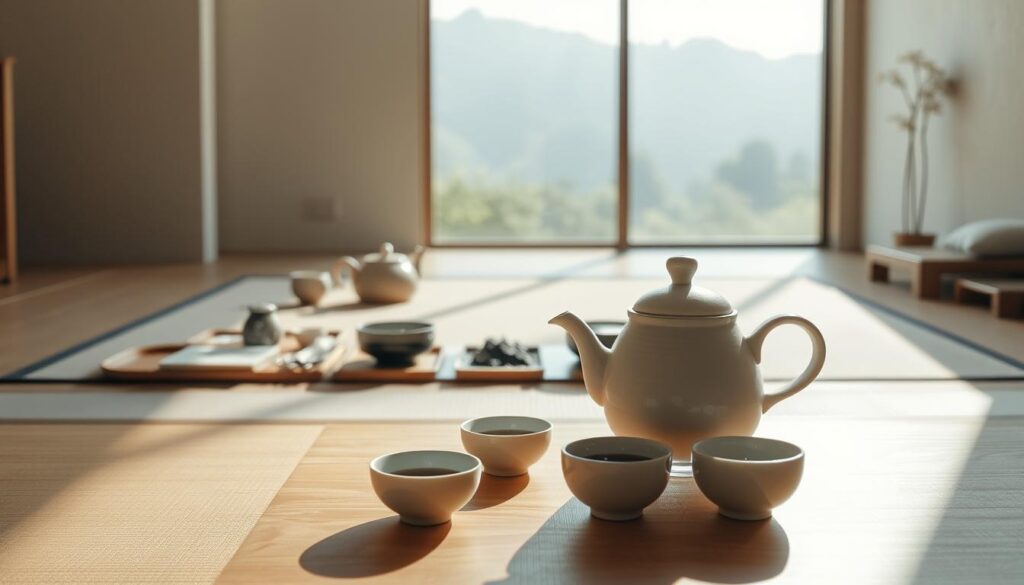
| Element | Purpose | Suggestions |
|---|---|---|
| Color Scheme | Create a calming environment | Pastel hues, soft greens |
| Tea Supplies Arrangement | Streamline preparation | Elegant containers, tea trays |
| Music | Enhance ambiance | Soft instrumentals, nature sounds |
The Steps of Making Mindful Tea
Starting your tea brewing journey includes careful steps that make it special. First, pick the right amount of tea leaves. This depends on your taste and the tea type. Each tea kind blossoms beautifully under the right care.
Then, heat your water to the perfect temperature. This changes depending on the tea. For example, green teas need cooler water than black teas. Below is a guide for different teas:
| Type of Tea | Ideal Temperature (°F) | Tea Brewing Time (minutes) |
|---|---|---|
| Green Tea | 160-180 | 2-3 |
| Black Tea | 200-212 | 3-5 |
| Oolong Tea | 190-210 | 4-7 |
| Herbal Tea | 200-212 | 5-7 |
Once the water is hot enough, pour it over the leaves. Watch the time closely to get the best taste and smell. Each tea has its unique flavor to explore with the right steep time.
While waiting, breathe in the tea’s aroma. This makes your tea time more enjoyable and builds excitement for that first taste. Stay in the moment, feeling the heat and smell of your brewing tea.
After brewing, strain the leaves and fill your favorite cup. Making mindful tea goes beyond just drinking. It’s about enjoying every part of the process, turning each sip into a little celebration.
Savoring the Experience: Drinking Mindfully
Practicing mindful drinking turns your tea time into something special. Before drinking, notice the cup’s warmth in your hands. Holding the cup connects you to the tea and lifts the experience.
When you sip the tea, pay attention to its different tastes. Begin with a tiny sip and let the tea linger in your mouth. This helps you enjoy the tea’s rich flavors more. Think about the smell, feel, and how it tastes as you drink. Every sip becomes a journey of discovery.
Thinking about the tea as you drink connects you more to the moment. Reflect on how the tea affects your feelings and thoughts. This mindfulness makes each cup more meaningful. By focusing on mindful drinking, you enjoy the flavors and the new insights you get.
| Aspect | Mindful Drinking Focus | Outcome |
|---|---|---|
| Initial Sip | Small, deliberate sips | Enhanced flavor appreciation |
| Engagement of Senses | Aroma, texture, temperature | Deepened connection with tea |
| Personal Reflection | Feelings and thoughts observed | Broader understanding of tea effects |
Incorporating Mindful Tea into Your Daily Routine
Adding a daily tea ritual to your routine brings stability and mindfulness. Starting with tea in the morning sets a positive base. It helps you set goals and find peace before starting your day.
An afternoon tea break offers a refreshing stop in a busy day. This pause is not just enjoyable. It also sharpens your focus and clears your mind.
Ending your day with tea helps you relax and get ready for sleep. Teas like chamomile or peppermint are great for easing into the night. They help you move smoothly from daytime to bedtime.
Planning tea moments through your day adds mindfulness. This creates a balanced flow in your life, improving your mental and emotional health.
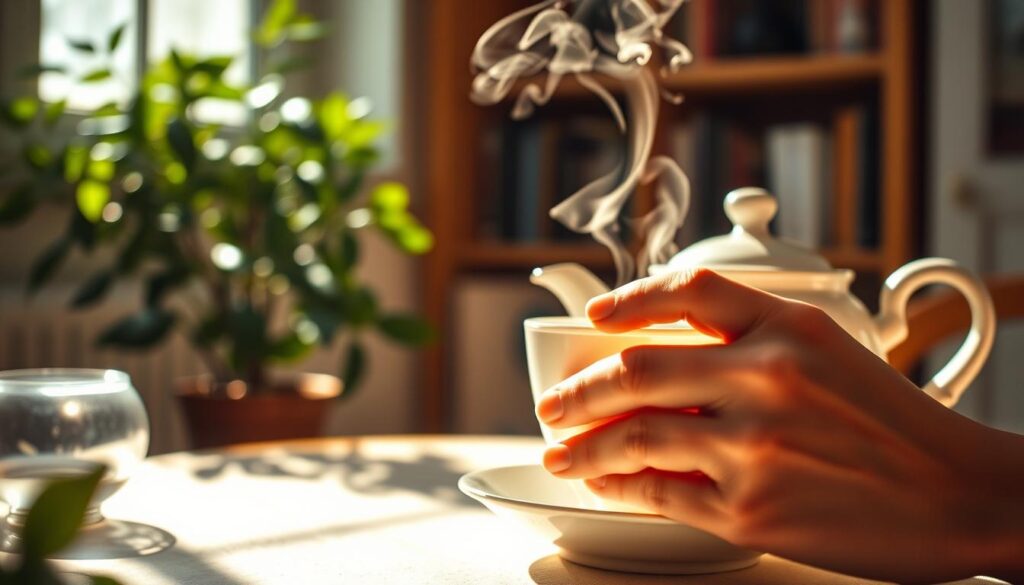
| Time of Day | Focus of Ritual | Tea Type Suggestions |
|---|---|---|
| Morning | Set intentions for the day | Green tea, black tea |
| Afternoon | Pause and refresh | Oolong tea, white tea |
| Evening | Relax and unwind | Herbal tea, chamomile |
The Role of Tea in Mindfulness Practices
For a long time, tea and mindfulness have been connected, especially in meditation. Brewing and drinking tea mindfully turns a simple act into a focused moment. This boosts your awareness and makes your mindfulness journey richer.
Focusing on preparing tea creates a calm space. Different teas have unique compounds, like L-theanine in matcha, that help clear your mind and relax. This focus through tea betters your meditation and connects you deeper with your senses.
Adding tea to your daily mindfulness adds a stable element, bringing more peace and purpose. Each cup you make is a chance for quiet and reflection, making your mindfulness practices richer.
Sharing Mindful Tea with Others
Sharing tea with others makes the experience better. It helps build a mindful tea community. Hosting tea gatherings lets you form deeper connections and have meaningful tea chats. Coming together over tea lets everyone share and learn from each other’s thoughts and stories.
To make your tea gatherings better, try these tips:
- Invite guests to share their personal tea stories.
- Start conversations on topics like the importance of rituals.
- Talk about different teas and their health perks.
These tips not only make tea sharing special but also strengthen your tea community ties. By making everyone feel welcome, you help them discover more about tea and mindfulness. This enriches both your practice and theirs.
Exploring Different Tea Cultures
Diving into the world of tea cultures opens up a new appreciation. Each culture has its own way of preparing and enjoying tea. This brings a rich variety of global tea rituals into your life. For example, the Japanese tea ceremony, or Chanoyu, is more than just drinking tea. It’s a careful practice that shows mindfulness, respect, and artistry. Getting to know these traditions can make your connection to tea stronger. It also shows how important tea is in different cultures.
Around the world, tea is celebrated in many special ways. In China, the Gongfu tea ceremony focuses on the art of brewing. This is to make the most of the tea’s flavors and nuances. Similarly, British afternoon tea is about social customs. It shows how tea ceremonies can bring people together for a good chat and bonding. By exploring these traditions, you’ll see that global tea rituals are not just about the tea. They’re also about the community and customs that come with it.
As you learn about different tea cultures, think about how they can make your tea time more mindful. Bringing elements from these traditions into your own can offer new insights. It promotes not only enjoyment but also a deeper understanding of cultural diversity. In the end, appreciating the cultural importance of tea helps you connect more with the drink and its origins.

